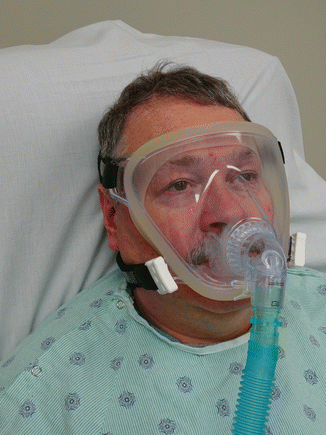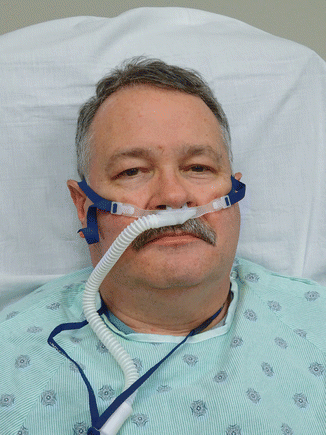Fig. 5.1
Chest x-ray
Question
What is the next appropriate step in the management of this patient?
Answer
Depending on her goals of care, this patient should most likely be intubated and undergo invasive ventilation.
While non-invasive ventilation has been shown to be effective and safe in patients with exacerbations of COPD and CHF, other conditions are more controversial. The use of NIV in patients with pneumonia who progress to acute respiratory failure has been associated with a high failure rate and rapid deterioration, leading to worse outcomes, including increased mortality. Both NIV (Fig. 5.2) and the use of high-flow, heated, humidified oxygen delivered by nasal cannula (Fig. 5.3) (see section “Evidence Contour”) may improve respiratory and gas exchange parameters, but it is challenging to predict which patients will definitively improve with this strategy. Individualized care and continuous bedside reassessment are essential. In this case, the patient was emergently intubated and treated with broad-spectrum antibiotics prior to ICU admission. After 4 days, she was successfully extubated and transferred to the general medical ward, where she continued to improve prior to discharge on oral antibiotics.



Fig. 5.2
Non-invasive ventilation by full face mask

Fig. 5.3
Hi-flow nasal cannula
Principles of Management
Definition
Acute respiratory failure manifests as hypoxemia and/or hypoventilation, which can lead to global ischemia and acid/base disturbances. Depending on patient factors and the type of respiratory failure, patients generally require some degree of respiratory support, ranging from supplemental oxygen via nasal cannula to high-flow oxygen therapy, non-invasive ventilation, and invasive ventilation. High-flow oxygen therapy can be delivered via face mask or high flow nasal cannula (Fig. 5.3). The term non-invasive ventilation (NIV) encompasses all forms of mechanically assisted ventilation without an artificial airway in place. NIV refers to both negative pressure ventilation (no longer used in clinical practice) and positive pressure ventilation modes, which include continuous positive airway pressure (CPAP) and bilevel positive airway pressure (BPAP) ventilation. Both are typically delivered via a tightly-fitting mask, which can be fitted over the nose, nose and mouth, face, or entire head. CPAP delivers various air/oxygen ratios at a constant pressure throughout both inspiration and expiration, which can improve alveolar recruitment and capillary oxygen delivery. BPAP provides both this continuous level of baseline expiratory positive airway pressure (EPEP) and then a higher level during inspiration (IPAP). Depending on the settings, cycling between these two pressure levels is triggered by the patient and/or a pre-set rate chosen by the clinician.
The theoretical benefit of BPAP over CPAP is this additional pressure support during inspiration, which can augment the patient’s tidal volume and reduce the mechanical work of breathing [1]. Because of their impact on intrathoracic pressure, both of these modes of NIV can also have hemodynamic effects, including both preload and afterload reduction. Depending on the patient and pathology, these effects can offer additional therapeutic benefit, but can also exacerbate hemodynamic compromise.
Indications, Contraindications and Settings
The most widely accepted indications for the use of NIV in the acute setting include respiratory failure due to acute decompensated heart failure (ADHF) and acute exacerbations of chronic obstructive pulmonary disease (COPD). Early use of NIV is associated with improved survival in patients with these conditions [2, 3]. Common chronic indications include obstructive sleep apnea and restrictive diseases of the chest wall, such as muscular dystrophies and obesity hypoventilation syndrome. In order for NIV to be safe and effective, patients’ mental status must not be altered to the point where they will not cooperate with the clinician or tolerate the face mask, nor should they have impaired inability to protect their airway from excessive secretions or emesis. Specifically, this includes all unresponsive and apneic patients, in whom intubation and invasive ventilation is the only reasonable mode of ventilatory support. Certain craniofacial abnormalities may also prevent an effective mask seal.
Patients with ADHF develop respiratory failure due in part to the presence of pulmonary edema [1]. CPAP is commonly used in these patients, as it can provide rapid preload and afterload reduction and augment alveolar recruitment, improving oxygenation and minimizing ongoing coronary ischemia [4]. CPAP is often initially set at 5 cm H2O and titrated to a combination of patient tolerance and clinical effect. If they tolerate the mask, patients often describe an initial subjective improvement in their work of breathing. Objective clinical improvement, such as the resolution of pulmonary rales and jugular venous distension, usually lags somewhat behind.
BPAP can be a particularly helpful mode in patients with impaired gas exchange secondary to respiratory muscle fatigue, as commonly seen in patients with acute exacerbations of COPD. Beyond the alveolar recruitment conferred by the baseline EPAP, the addition of pressure support during inspiration can provide a mechanical advantage and thus further decrease the work of breathing, which otherwise consumes a tremendous amount of metabolic energy. Additional IPAP also creates more effective airway ventilation and CO2 removal. Typical initial BPAP settings are an EPAP of 5 cm H2O and an IPAP of 10 cm H2O. In response to persistent respiratory acidosis, IPAP may be increased (usually in increments of 2 cm H2O). This increases the difference between EPAP and IPAP, which is the primary contributor to augmented ventilation. In response to persistent hypoxemia, EPAP may also be increased in increments of 2 cm H2O. This is most likely to augment alveolar recruitment and oxygenation. Clinicians should be mindful that the pressure required to overcome the tone of the lower esophageal sphincter is approximately 20–22 cm H2O. Keeping the IPAP below this level may reduce the risk of accidental gastric insufflation, vomiting, and possible aspiration.
Predictors of Failure of Non-invasive Ventilation
It is important to recognize when a patient may not improve with NIV. Very limited evidence is available to guide decision-making in these patients. In a 2003 prospective cohort study of severe dyspnea due to decompensated heart failure, Giacomini and colleagues derived a crude protocol that addresses the transition from the emergency department to inpatient care for patients stabilized with NIV. After a 90-min trial of NIV, patients who felt subjectively better and tolerated at least a 15-min period of oxygen by reservoir mask were admitted to a general care ward. None of these “responder” patients were subsequently intubated or transferred to ICU [5]. Patients who remained tachypneic, acidemic, or hypoxemic after a trial of NIV (60–90 min), and those who developed hypotension, were unlike to improve. For these “non-responder” patients, endotracheal intubation and invasive ventilation should be strongly considered, as the role of prolonged acute treatment with NIV is still unclear.
Strong evidence outlining safe titration of NIV in other patient subgroups is lacking. Factors to consider include patient comorbidities and physiologic reserve, as well as the expected time course of reversibility for the cause of their acute respiratory failure.
Evidence Contour
Use in Patients with Pneumonia
The use of NIV in acute respiratory failure has been studied for indications other than decompensated heart failure and COPD [6–10]. Pneumonia is not considered an appropriate indication for the use of NIV for patients in acute respiratory failure. Although NIV offers a less invasive intervention for respiratory distress, the NIV failure rate in patients with pneumonia has been reported as high as 50 % [7]. It is very difficult to predict which patients will improve and which will deteriorate [7], and among those who decline there is an increased incidence of peri-intubation complications and a significant increase in mortality [9, 10]. Several possible explanations for this have been proposed, such as the increased metabolic demands in patients with pneumonia, the inability to adequately clear respiratory secretions, and the protracted time course of pneumonia when compared to other common indications for NIV. Possible exceptions to the poor performance of NIV in patients with pulmonary infection include patients with pneumonia and COPD with hypercapnic respiratory failure. This may be due to overlap in diagnosis between COPD exacerbation and true infection [8]. Other possible exceptions include neutropenic patients with hematologic malignancy, or recent solid organ transplant recipients with suspected pneumonia, possibly because these patients have a higher incidence of viral pneumonia than immunocompetent patients [11–14]. Overall, these data are still relatively sparse. If NIV is attempted in these patients, the clinician should provide near-continuous bedside reassessment and not hesitate to intubate if there is no significant improvement.
Use in Patients with Asthma Exacerbation
NIV has also been used in patients with acute exacerbations of asthma, however there is only limited evidence to help guide the clinician. The available studies fail to demonstrate improvement in mortality or intubation rates, but show an apparent decrease in hospital admission rates, hospital length of stay, symptom severity, and indirect markers of severity, such as pulmonary functions tests or arterial blood gases [15–18]. However, the are no high-quality studies addressing the use of NIV in patients with the most severe forms of asthma exacerbation, limiting any conclusion regarding its impact on mortality and intubation rates in this patient population [19]. For patients with severe asthma exacerbations, NIV should be used with caution, in the context of maximal medical therapy and continuous bedside reassessment.
Use in Patients with ARDS
Limited evidence suggests that NIV might be associated with decreased intubation rates in select patients with early mild ARDS, however overall mortality rates seem to be unchanged, and very close clinical monitoring is required [20–22]. NIV is not appropriate as a first line approach for established ARDS, given the importance of careful control of tidal volume and airway pressure in this syndrome [23].
Use of NIV in Patients with Altered Mental Status
As mentioned, one of the most common traditional contraindications for the use of NIV is significantly altered mental status, because of the concern that these patients have compromised airway protective reflexes and are not able to adequately manage pulmonary or oropharyngeal secretions. Vomiting into the positive pressure mask is potentially catastrophic in these patients. For intoxicated patients with respiratory distress NIV is almost never the safest alternative, because of unpredictable toxicokinetics and the risk of vomiting. Though NIV can be of great utility in patients with acute exacerbations of COPD, these patients frequently exhibit altered mental status due to hypercapnia. Low to moderate quality evidence suggests that select patients with hypercapnic encephalopathy may warrant a trial of NIV if very close monitoring is feasible [24, 25]. Any such attempt should be aborted if there is no significant improvement in mental status within a short period [24].

Full access? Get Clinical Tree







